|
Polandry, the estate of a woman having several husbands, is exceedingly rare, and has most often showed up not as a sign of liberation but in societies that murdered girl babies and so ran short of brides
|
My pupose in this essay is to look at biblical polygyny (two or more women being simultaneously married to one man) by making a comparison with various other non-monogamous marriage practices and to see what can be learned about the divine imprint in the human character. I will be asking myself a number of questions
en route such as: what is the need for polygyny in the first place? Are we created to be basically monogamous as would seem to be indicated in the garden of Eden story? And if this is so, what need is there of polygyny? Is polygyny simply a contingency plan to help single mothers or does it have a special purpose not at first discerned in the basically monogamous Garden of Eden account? If polygyny, why not polyandry too? I hope this essay will stimulate our readers to ask themselves such questions and to probe the Bible for answers in areas which they may not previous have considered.
A History of World Polyandry
I have decided to start my exploration in a rather unusual place, namely, polyandry, which is the practice or two or more men being married to one woman. If we are to understand polygyny, and particularly if we are to present a defence of it to the world not only in terms of theology but also of sociology, then we must at once answer the legitimate question: if polygyny, why not polyandry also? Or even mixed marriages of several men and women all being married together (polyamory)?
Polyandry is know to have been practiced - and is still practiced - in Africa, India, Polynesia and America. It is not common in Africa, but in the northeast of the continent among the Banyabkole and kindred tribes, the system arises from poverty. A man asks one or more of his brothers to join him in the necessary gifts for procuring a wife, and she thus becomes the legal wife of all who contributed to the dowry and lives with each brother in turn. When pregnant, the wife remains with the eldest brother until her child is born and all offspring are recognised as the children of the eldest brother. In this respect there are similarities with the Hebrew law of Levirate (from the Latin levir meaning 'husband's brother'); when a married man died without a child his brother was expected to take his wife and raise up seed in his name. The children of this marriage counted as children of the first husband (for biblical examples, see Deuteronomy 25:5-10; Ruth 4:17; Num.ber 7:1-11; Leviticus18:16; 20:21; Matthew 14:3-4; 22:23ff). But the reasons for practice of the principle are radically different - one is motivated by poverty and the other by divine ordinance to further the name on earth of a husband without a male heir following his death.
It would appear that among the aboriginal tribes of India marriage was both monogamous and endogamous. Prenuptual sexual acts were lightly regarded so long as they took place within the tribe. The penalty of excommunication was inflicted, however, if such conduct involved a member of another tribe. Occasionally some more primitive tribe will be found to be polygynous (as is true of the Sora tribe of south-east India which has been converting to the Reorganized Church of Jesus Christ of Latter Day Saints, a monogamy-only break-off of the larger Mormon Church and today called the 'Community of Christ', and whose polygamy has been tolerated for the current generation - RLDS D&C 150:10-11). In some tribes child marriage seems to be the rule, whereas in others marriage takes place only in adulthood. Occasionally a ritual of marriage by capture was enacted (cp. the biblical account of the preservation of the tribe of Benjamin when it seized women at Shiloh - Judges 19-21, esp. 21:16-24), and in some parts of India polyandry and group marriages have been found. Whilst polygyny is very ancient in India, and does not give the slightest offence in the Brahmanic system, polyandry is utterly repugnant to Indian feelings, only two cases being found in epic literature. However, there seem to be traces of a very early polyandry and 'free love', where the women followed their own inclinations and jealosy was unknown. This belongs, however, to a legendary period.
There are but two tribes in the world where polyandry is stable, preferred, and regarded as the normative as the normative form of marriage. These are the Todas of southern India and the Marquesans of Polynesia.
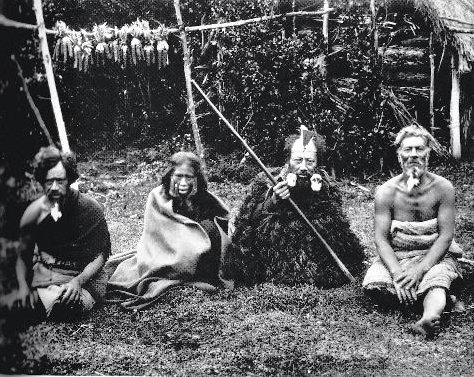 Marquesans
Marquesans
Among the Todas the preferred form of polyandry is fraternal, that is, the wife marries a series of brothers (cp. the Banyankole of Africa). Only occasionally is the nonfraternal type to be found. Among the Marquesans the nonfraternal form is common. In Toda polyandry several brothers establish a common household with one woman. Paternity of the children is determined by ritual in which one brother presents the wife with a toy bow and arrow and the offspring following this rite are credited to the husband who executed the ritual. Only when another husband carries out out the bow-and-arrow ceremony does paternity go to him, but again all the children are ascribed to the last husband to carry out the rite, even though he may have been dead for years. Among the Todas polyandry is definitely associated with low economic status. In fact the nobility not infrequently practices polygyny. When the co-husbands are brothers they occupy one house, but in the occasional examples of nonfraternal polyandry they have separate dwellings and the wife rotates her visits among them.
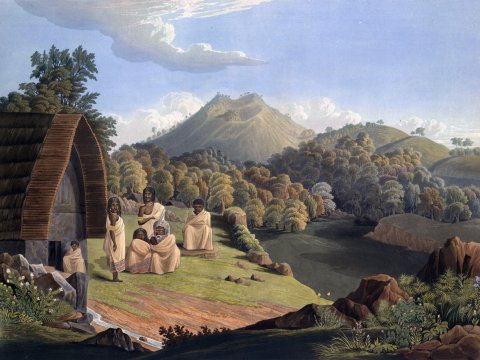 Todas
Todas
In the Marquesas polyandrous marriage is as stable as any other. There is usually a main husband who acts as an agent for his wife in the management of family affairs. The other husbands are not his brothers but the younger sons of families of lower rank, or 'male concubines'. They are, however, accorded considerable latitude and may leave one household and join another. Here, too, economic conditions are severe. Cultivation is difficult and the islands are subject to periodic droughts leading to crop failures, water shortages, and severe epidemics. Fishing is dangerous and difficult in the deep waters off the mountaineous islands. Given that 80% of all the peoples in the world allow polygynous marriage (Marvin K. Opler, Polyandry, Am.J.Sociol., Sept. 1943) it is extraordinary that an exception such as polyandry exists at all. Everywhere else in Polynesia polygyny is the norm.
In the Americas among the Indians, polyandry occurred sporadically, frequently taking the form of a temporary union prior to marriage in the Shoshoni tribe. The occurrence of fraternal polyandry amongst the south American Taruro and Cawahib implies an institutionalized practice, but polyandrous families were infrequent. The Caingang, describes as casual in their regulation of sex, had no more than 14% polyandrous marriages. They also provide the only instance of polygandrous, or 'group' marriage (barring the north American Oneida community which will be discussed presently), totaling 8% of 308 marriages (The Encyclopaedia of Sexual Behavior, Vol.1, ed. Albert Ellis & Albert Abarand, London: 1961, p.105).
Polyandry is a form of marriage "socially sanctioned and culturally patterned" involving "residential cohabitation as well as sexual rights" (George Peter Murduck, Social Structure, MacMillan, New York, 1949). However, it occurs so infrequently that it may be regarded as an ethnological curiosity. Although some cultural anthropologists have described the occurrence of polyandry in certain north American Indian tribes, this is, strictly speaking, not the case. What has been mistaken for polyandry, Opler notes (Marvin K. Opler, Polyandry), was usually an example of extra-marital sex of a woman with a number of men, sometimes the brothers of her husband.
Polyandry is highly infrequent, perhaps because it goes counter to the biological tendency (fallen human nature) of the male to demand exclusive possession of his mate, or because it runs counter to the divine pattern of the patriarchy which the biblically-based Hebrew-Christian theologies subscribe to. As far as the former proposition is concerned, if it is true, then culture counteracts biology when polyandry occurs. The explanation is complex, but an important consideration seems to be the scarcity of women in societies where polyandry is practiced, a scarcity resulting from female infanticide. Among the Todas, for example, the sex-ratio was 127-259 males to 100 females. But why the infanticide? The answer is probably the extreme poverty of the people, resulting from the inhospitable environment. That this is not the sole reason for polyandry is shown by the fact that other societies have as extreme poverty with infanticide, and still others practice infanticide when the poverty is not so great (e.g. abortion amongst Asian women in Great Britain). In the remote Himalayas, where arable land is scarce, fraternal polyandry is practiced, a group of brothers sharing a wife. All the children are regarded as the offspring of the eldest brother. When the brothers die, the estate goes to the sons, who in turn marry one wife. Polyandry seems to be associated with a system of land tenure that prevents fragmentation of already small holdings. There is also a nonfraternal variety, such as that found among the Marquesans. However, polyandry is very rare and is incompatible with the surplus of women generally to be found in human societies.
The Hebrew Tradition
Polyandry per se was totally unknown amongst the Hebrew race through the practice of the levirate was used subsequently by the early Mormons to justify the marriage of several men to one woman whilst the husbands were still alive.
When a married man died without a child it was the responsibility of his brother to take the widow to wife and raise seed to the first husband. This custom is found amongst other people besides the Hebrews.
The custom is assumed as early as the story of Onan (Genesis 38:8-10). Onan took his brother's wife but refused to have a child by her because "the seed should not be his" (v.9), and his own children would not have the primary inheritance. For his selfishness, Yahweh struck him dead (and not, as some have suggested, for the act of spilling his seed on the ground).
In part the levirate was given to ensure that the widow's family was not dispossessed of its inheritance. Though expected of the eldest brother-in-law of the widow, compliance was not manditory (Deuteronomy 25:5-10). A good example of the levirate in action is to be found in the story of Ruth, showing that in fact the custom extended farther than the husband's brother. Here an unmarried kinsman has the primary duty, and only when he refuses does Boaz marry Ruth. A further extension of the custom here is that it is Ruth, and not Naomi, who marries Boaz, presumably because Naomi was too old to bear a child. Nevertheless Ruth's progeny is called "a son to Naomi" (Ruth 4:17).
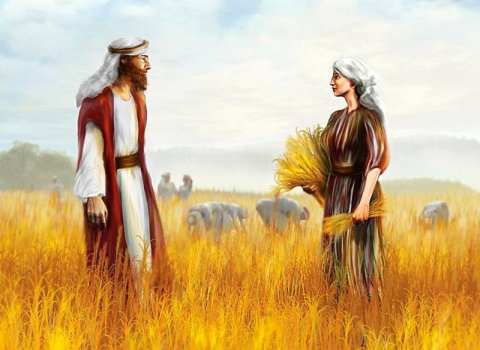 Ruth and Boaz, an Example of a Levirate Marriage
Ruth and Boaz, an Example of a Levirate Marriage
The levirate did not apply if daughters had been born, and regulations for the inheritance of daughters are given to the daughters of Zelophehad (Numbers 27:1-11). This apparent ignorance or contradiction of the levirate law has confused many scholars and biblical exegetes who have proposed that Deuteronomy 25:5-10 had not been promulgated. On the other hand, when a law arises out of a specific occasion one must know the exact circumstances in order to judge what the law professes to cover. There would be no contradiction of the levirate law if Zelophehad's wife had died before he did, and the law here confines itself to similar cases. Thus the levirate law and its extension would be valid, though not compulsory, when there were no children. Numbers 27:8-11 would operate when there were daughters only, or when a childless wife had predeceased her husband, or when the late husband's brother refused to take the childless widow, or when the wife remained childless after the brother married her.
In Leviticus 18:16 and 20:21 a man is forbidden to marry his brother's wife. In the light of the levirate law this clearly means that he may not take her as his own wife, whether she has been divorced during her husband's lifetime of has been left with or without children at her husband's death. John the Baptist rebuked Herod Antipas for marrying the wife of his brother Herod Philip (Matthew 14:3-4) who was still alive.
It is therefore clear that the levirate law was in no sense polyandry for the brother thus fulfilling this law was never, in any sense of the word, a true 'husband' but served only as a temporary proxy. This is important to bear in mind when we come to consider the justification used by some Mormon cults in maintaining the validity of polyandry by extending the levirate to include eternity as well as time. The practice of polyandry under the Mosaic covenant in Old Testament times would have been regarded as adultery and been punishable by death (Leviticus 18; 20:10). To even behold the nakedness of any woman other than a man's own wife was considered a great evil, even within one's own family (Leviticus 20:17-21).
Unlike the polyandry is practiced in pagan nations (such as India, Africa, and Polynesia), the Hebrew laws of marriage regarded such as an abomination and even legislated in the matter of the covering up of nakedness so that a woman would never be seen unclothed save by her husband in the covenant. Likewise the evidence suggests that similar laws obtained in the pre-Mosaic era, in the days of the Patriarchs.
The Christian Tradition
The Christian tradition on marriage has differed little from the Hebrew one that it inherited. The sin of adultery is reaffirmed (Matthew 5:27-28; 19:9; Mark 7:21; 10:11; Luke 16:18; John 8:3f; 2 Peter 2:14). And the only instance where marriage is discussed at all in the New Testament is to be found in Matthew 22:23f (and parallel passages in the Synoptics) where the levirate law (Heb. yibbum) is used by the Tz'dukim (Sadducees) to pose a question about marriage in the resurrection. Yah'shua (Jesus) affirms in His response to the Tz'dukim (Sadducees) that the levirate brothers to the woman in question are neither real 'husbands' from the point of view of the levirate law (except the first one), and that such as they (who did not believe in the resurrection) "neither marry, nor are given in marriage, but are like Elohim's (God's) angels in heaven" (v.30, WEB).
That is all we are told about marriage in the Synoptics. There is no evidence that the laws of marriage of the early Christian Church/Messianic Community were any different from the Torah (Law) of Moses which it inherited. The first Christians/Messianics retained the basic Hebrew structure of polygyny and monogamy, and as to who practiced which was likely determined by the religious class of their origin. Thus amongst Hebrew converts there would have been those practicing both monogamy and polygyny, depending on their class and spiritual background. By this time there was, as there is in orthodox Christianity today, an established class like the Pharisees who opposed polygamy, a prejudice acquired during the Babylonian captivity period, and ordinary folk with financial means who embraced it. At the same time the Church experienced an influx of ever increasing numbers of Gentile pagans with an exclusive monogamous tradition linked to extreme promiscuity. Whilst the New Testament neither affirms nor rejects polygyny, orthodoxy has traditionally cited 1 Timothy 3:1-2,12 as evidence that polygamy was no longer a Christian tradition. This passage is, however, a little strange, for English translations leave the reader with the impression that whilst the Elders and Deacons were not to have more than one wife that the lay members could, if they wished, have several. Not until the advent of the Christian polygamist movement in the 1990s was the translation of this and a parallel passage, which apparently limits a church leader to being "the husband of [but] one wife" (NIV), seriously questioned, for this may equally well be rendered as "the husband of his first wife", meaning that a church leader must set an example in marriage by not divorcing the wife of his youth for other ones.
We do not, unfortunately, have a lens that allows us to look into marriage practices of the early Church/Messianic Community for history on this subject is silent. All that we do know is that catholicising tendencies, which arose in opposition to various heretical groups, led ultimately to polygyny being banned and asceticism promoted that held up celibacy as the highest virtue. Perhaps because the Gnostics, who admitted polygyny though rarely practiced it, were heretical, polygyny obtained a stigma which it never deserved. On the other hand, many Gnostic sects did repudiate the practice and like their catholic opponents opted for either monogamy or celibacy. The Cathars, a French gnostic sect, looked upon marriage in much the same way as the American Shakers though did not forbid the holy estate save within the priestly class where priesthood was open to both men and women. It does not seem, though, that polygyny ever played any substantial part in the Gnostic traditions.
By the sixth century polygyny had all but been extirpated from amongst both the orthodox as well as the heretical sects. Yet inspite of its suppression it was sometimes entertained as a topic of discussion by theologicans and philosophers, sometimes at great personal risk. Even the great Reformer, Martin Luther, countenanced it, never denying it as biblical truth, but rejecting it for political reasons at a time when its practice might have resulted in victory Catholic counter-Reformation. On the one occasion he permitted a highly promiscuous prince to practice it in order to placate him at a time when the Reformation required all the political support it could get, he later bitterly regretted it, and after the brief and tempestuous rise and fall of the German polygynous Münsterite sect, polygamy as a Christian practice effectively remained dormant until the nineteenth century.
In the meantime, some dared to raise the question in anonymous tracts and risked their lives for doing so. In the 16th century of XXX Dialogues and the 21st (no.XXI) entitled, Dialogue on Polygamy caused a furor. A dialogue between one Ochino (a monogamist) and Telypolygamous (naturally, a polygamist) occurs. Cairncross recalls:
"God commands that a man shall cleave to his wife (says Ochino). Certainly, says his opponent, but God also orders us to cleave to our neighbour. There is nothing to prevent us from cleaving to more than one. The same proposition applies to wives. Nor does God say of the first couple that 'the twain shall be one flesh'. He says that 'they shall be one flesh'. He does not specify that there shall be only two. A man could be equally one flesh with a hundred wives. If matrimony is not in itself evil, it cannot be evil with two wives. But, if more than two can cleave together, why cannot men cleave to one woman? As Ochino says, 'One woman can after all to do with several men - and there are sick men as well as sick women.' Telypolygamous gives the traditional reply that man is the head of the woman and it would be monstrous for a body to have two heads. In any case, polyandry does not further procreation, which is the main objective of marriage" (John Cairncross, After Polygamy Was made a Sin: The Social History of Christian Polygamy, Routledge & Kegan Paul, London: 1974, p.68-69).
There have always been two major biblical objections in the Christian debate on polyandry:
- (1) That the man is the head of the woman (Genesis 3:16; 1 Corinthians 11:3; Ephesians 5:23; 1 Timothy 3:4) and therefore polyandry would destroy the divine pattern, causing chaos in terms of authority; and
- (2) That it hindered the multiplication of the species, also given by divine command. Or as deBeze summed up: "Nature is as it is" (Theodore deBeze, On Polygamy and Divorce, Geneva: 1596, pp.5-6).
"...polyandry, for all polygamists", says Cairncross, "is definitely banned. The Bible says that a man cannot have two masters (Matthew 6:24), but it never says that a master cannot have two servants. Since woman is the servant of man, it follows that he can have several wives, but a woman cannot have several husbands. However, male rule over the woman should not be that of a tyrant over a slave (Ephesians 5:22ff) but paternal, as of a father to his chldren" (Carncross, opt.cit., p.80).
The famous English poet, John Milton, joined in the chorus by contrasting "the liberty, not unnatural, to have many wives" with the alleged polyandry of the ancient Britons whom he denounces as "much more absurd and preposterous in their licence" (John Milton, History of Britain: 1670).
Only Patrick Delaney, an Irish clergyman, seems to have come to the defence of polyandry; polygyny, he argues, offends against the rule of "the natural equality of desire...between the two sexes", for in it desire "can only be gratified in one sex." Consequently, the other sex is injured in its rights. He is frank enough to admit that this reasoning "will give some room for idle wit". But he firmly asserts that there are cases of a strong sex drive both in men and women, and that monogamy may bear hard on both. But, if polygyny is to be allowed to ease the strain, so in fairness must polyandry (Patrick Delaney, Complete Works, vol.18, pp.430-1). It is perhaps little wonder that Delaney's book was well received, and knew two English, one German, and one Dutch edition!
And thus a third point in the justification or repudiation of polyandry was raised:
- (3) Sexual appetite, an attitude which perhaps belongs to the so-called 'Enlightenment'.
Liberal attitudes in Christendom were to sweep away any thought of polygyny or polyandry, and, eventually, marriage too. Thomas Cookson was typical of this trend which not only challenged the validity of marriage but also the reliability of the scriptures by linking social institutions with education and the advance of reason. Moses, he argues, tolerated polygamy, since "these were not the times for perfect institutions". He cites, as an illustration of his philosophy, the attempt by England to lead India to a more rational code of ethics. "That the laws of England are preferable to the laws of Hindostan is a truth that is self evident. But yet these laws were ill received there, and the reason is that they were too precipatately introduced - introduced before prejudices had been done away with by the people being gently civilized." Polygyny and polyandry are caused in the main "by want of a good system of education" (Thomas Cookson, Thoughts on Polygamy, London: 1782). They looked to the future with the calm confidence of the eighteenth century humanist.
And so, whilst polygyny was certainly entertained in the 'Christian' Old World, polyandry was almost universally denounced by both the Christians and humanists. It was not until refugees from religious oppression had settled in north America that polyandry was not only aired as a possible marriage practice but actually put into action, though never as a single cultural institution (as obtained with the Todas and Marquesas) but combined with polyandry in what is sometimes called 'multiple marriage' or polyandry. The two best examples of 'multiple marriage' are the Oneida Community and Nauvoo Mormonism (with some modern-day offshoots).
The Oneida Community
The Oneida Community grew out of the attempt to institutionalise holiness as a way of life. It arose in the backwash of early holiness ideas, particularly held by Methodists and by the revivalist Charles Finney. John Humphrey Noyes, a Congregationalist minister, espoused the idea that man could attain total security against the commission of sin - he could be perfect. In the late 1840s, following the explusion of the Mormons from Nauvoo, Illinois, he and his followers established the community that settled in Oneida. They believed, rather naïvely, that they were totally secure from sin; that only those descended from the early saints were perfect; that the second coming had occurred in AD 70 (preterism), and, most revelant to this study, that for the perfectly holy, marriage was abolished - a woman was the bride of Christ only, and therefore the bride of all the saints. (The best study made on the Oneida Community is probably Lawrence Foster's Religion and Sexuality, Oxford University Press: 1981, pp.72-122).
Devotion to property, monogamy, and the possessiveness of mothers towards their children, was regarded as a great sin. Noyes' advocacy was not promiscuity, but sexual communism among the totally sanctified. (In some respects the system foreshadows the abolition of marriage in the early years of the Bolshevik revolution, buts such chaos and negligence of children resulted in the rapid re-institution of monogamy which became the official norm in Soviet life). Thus sexual relations were not causual but were organised and disciplined. Oneida stood opposed to the type of spiritual wifery that had caused scandals when practiced among the perfectionists in New York state. Noyes advocated a eugenic policy of selected mating for the scientific propagation of the race (foreshadowing in some respects the Lebensborn of the nazi SS state), and thus demanded considerable sexual continence.
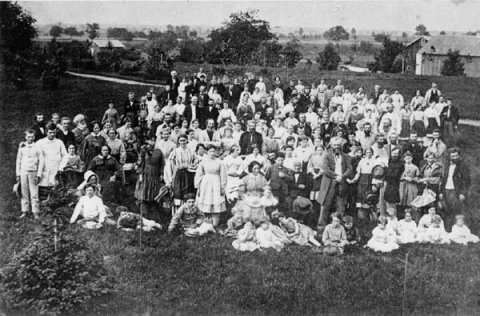 The Oneida Community
The Oneida Community
In 1880, the hostility of vociferous opponents exacerbated internal tensions and in 1881 the community abandoned sexual communism and the community of goods. Noyes' marriage system is best summed up in his own words:
"When the will of God is done on earth, as it is in heaven, there will be no marriage. The marriage supper of the Lamb, is the feast at which every dish is free to every guest. Exclusiveness, jealosy, quarrelling, have no place there, for the same reason as that which forbids the guests at a thanksgiving dinner to claim each his separate dish, and quarrel with the rest for the rights. In a holy community, there is no more reason why sexual intercourse should be restricted by law, than why eating or drinking should be - and there is as little occasion from shame in the one case as in the other. God has placed a wall of partition between the male and female during the apostacy, for a good reason, which will be broken down in the resurrection, for equally good reasons. But woe to him who abolishes the law of apostacy before he stands in the holiness of the resurrection. The guests of the marriage supper may have each his favourite dish, each a dish of his own procuring, and that without the jealousy of exclusiveness. I call a certain woman my wife - she is yours, she is Christ's, and in him she is the bride of all the saints. She is dear in the hand of the stranger, and according to my promise to her, I rejoice. My claim upon her cuts directly across the marriage covenant of the world, and God knows the end..." (Witness 1, January 23, 1839: p.49).
There are, of course, fundamental contraditions between Noyes' theory and the revealed Word of Elohim (God), not least a semantic one. According to the Oxford English Dictionary (Compact Edition of the Oxford English Dictionary, Oxford University Press: 1971, p.1730), marriage is defined as "the condition of being a husband or wife; or the relation between married persons; intimate union; the cermony or procedure by which two persons are made husband and wife". And in Hebrew there are many different words which we render into English as 'marry' or 'marriage':
- (1) halal = to be praised (Psalm 78:63);
- (2) baal = lord, master, owner (Deuteronomy 22:22; Jeremiah 3:14; Exodus 21:3; Isaiah 54:1, etc.);
- (3) nasa = to lift up (2 Chronicles 13:21).
But the principal meaning is 'ownership', a concept carried forward into the Greek New Testament. The principle thought is that Yahweh owns men and women, as men in their turn own women, 'owning' in the sense of 'being responsible for'. Far from marriage being abolished, which Noyes wrongly supposes from Yah'shua's (Jesus') saying in Matthew 22:23f, the very marriage feast Noyes references from the Book of Revelation (Revelation 19:1-10) is a marriage, which Paul says foreshadows earthly marriage in its perfect order. By denying the concept of earthly 'possession' or marriage, Noyes indirectly removes Yahweh's possession of men and women. Jealousy is categorised as sin but he fails to note that jealousy has both its good and bad aspects, Elohim (God) Himself indeed being jealous in the former capacity (Exodis 20:5; 34:14; Deuteronomy 4:24; 5:9; 6:15) as He expects His servants to be (2 Corinthians 11:2). As Elohim (God) is jealous for His bride - the Church/Messianic Community - so a man should be jealous for his wife. Indeed one might say that Elohim (God) is the Elohim (God) of nature, for which He died, in order to perfect it, not supplant it.
One wonders how such organized promiscuity might fare in our modern world given the prevelence of social diseases. One modern 'free love' cult, run by the late guru Rajneesh, has been virtually destroyed by such social diseases. Even if the prevailing attitudes had not been an obstacle to Oneida beliefs it is doubtful even if it would have survived. That it lasted 40 years is astonishing in itself.
Mormonism
When people think of early Mormonism they inevitably conjure up in their minds the polygamous hareems of Joseph Smith and Brigham Young. But what they do not perhaps realise is that polygyny was but the precursor to polyandry and sexual communism which the Mormon prophet had already begun to establish in Nauvoo prior to his assassination in 1844.
The first hint of marriage activities other than polygyny being enjoined in the early Mormon capitol of Nauvoo was first aired by Fawn Brodie in her well-known book, No Man Knows My History (Alfred A. Knopf, New York, 1982 edn.: p.304). Former Mormon apostle Orson Hyde leaves us with this insight into incipient Mormon polyandry:
"As a man's family constitutes his glory, to go on a mission for several years, leaving from two to a dozen wives at home, necessarily causes some loss of family, and consequently, according to Mormon notions, much sacrifice of salvation. This difficulty is however obviated by the appointment of an agent or proxy, who shall stand to themward in their husband's stead...This is one of the secret principles that as yet is only privately talked of in select circles, and darkly hinted at from their pulpits and in their works. They argue that the old Mosaic Law of a 'brother raising up seed to his dead brother' is now in force; and as death is only a temporary absence, so they contend a temporary absence is equivalent to death; and if in the case of death, it is not only no crime, but proper; so also in this case it is equally lawful and extremely advantageous! This practice, commended by such sophistry, and commanded by such a prophet [Joseph Smith, Jr.] was adopted as early as Nauvoo.
"Much scandal was caused by others than Smith attempting to carry out this doctrine. Several, who thought that what was good for the Prophet should be good for the people, were crushed down by Smith's heavy hand. Several of those have spoken out to the practices of the 'Saints' [e.g. John C. Bennett]. Much discussion occurred at Salt Lake City as to the advisability of revealing the doctrine of polygamy in 1852, and that has caused Brigham [Young] to defer the public enunciation of this 'proxy doctrine', as it is familiarly called. Many have expected it repeatedly at the last confereneces. Reasoning out their premises to their natural and necessary consequences, this licentious and infamous dogma is their inevitable result"
(Orson Hyde, Mormonism, pp.87-88).
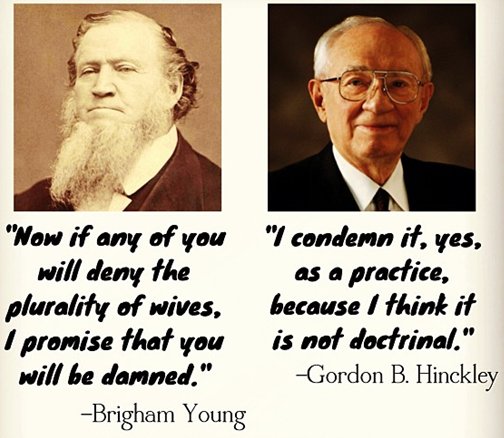
Mormon 'prophets' contradict each other in the matter of polygamy
The available evidence suggests that polyandry, if it was indeed practiced at all, was the sole province of Joseph Smith himself (Lawrence Foster, op.cit., p.164). It is known that 'dummy' marriages were performed in Nauvoo to conceal polygynous marriages in order to protect such women should they become pregnant but there is no suggestion that such 'legal' husbands ever had sexual relations with their 'legal' wives. In addition, it is known that many women joining the church married within it without divorcing their 'gentile' (non-Mormon) husbands, and were thus technically polyandrists (Fawn Brodie, op.cit., pp.335-6; Lawrence Foster, op.cit., p.314, notes 134ff). But as to the practice of literal polyandry, such would only seem to have been done by the Prophet himself, it at all. Certainly there are puzzling reports of Orson Pratt's and Orson Hyde's wives being involved in this principle in some way, and even one report that Emma Smith (the Prophet's wife) was offered either Brigham Young or William Law as a 'plural husband' in order to pacify her hostility towards polygyny (Wilhelp Wyl, Mormon Portraits, or the Truth About Mormon Leaders, 1830-1886, Salt Lake City, Tribune Publishing Company: 1886, p.108; and Wyl's interview with William Law in the Salt Lake Tribune, July 3: 1887).
A clue to what actually may have happened is to be found in the Mormon collection of Smith's revelations, the Doctrine & Covenants (the Utah edition) in the 'revelation' dealing with plural marriage. There are several verses within this revelation which have never been explained by Mormon apologists, and which are not touched in the existing Mormon commentaries. A suggested expansion of these enigmatic passages is given in {brackets}:
"If a man receive a wife in the new and everlasting covenant {monogamously or polygynously} and she be with a another man, and I have not appointed unto her {another man - polyandrously?} by the holy anointing {in other words, polyandry can only be appointed in the same way as polygyny}, she hath committed adultery and shall be destroyed. If she be not in the new and everlasting covenant {either monogamously or polygynously}, and she be with another man, she has committed adultery {because she cannot live polygynously or polyandrously unless she is in this covenant}" (LDS D&C 132:41-42).
It is difficult to explain this passage unless both polygyny and polyandry are being considered, particularly in the light of the following passage:
"A commandment I give unto mine handmaid, Emma Smith, your wife, whom I have given unto you {in the new and everlasting covenant} that she stay {stop} herself and partake not of that which I commanded you to offer unto her {a second husband polyandrously} (It was said in Nauvoo that Emma had the choice of marrying either Brigham Young or William Law, and that the Prophet preferred Young. But she chose Law, who shortly thereafter apostalised because of problems in accepting polyandry, and the Prophet feared he would); for I did it, saith the Lord, to prove you all, as I did Abraham, and that I might require an offering at your hand, by covenant and by sacrifice" (LDS D&C 132:51).
If Joseph Smith was indeed instituting polyandry the last passage seems to leave little doubt that it was a principle commanded by God to be entered into merely as an 'Abrahamic test', to be withheld at the last moment before its implementation, just as Abraham was restrained at the moment he was about the fulfill Yahweh's command to ritually sacrifice his son, Isaac (Genesis 22:1-19). This is the 'official' Mormon view. They say that it was to put the men through the same kind of heart-wrenching that the introduction of their brand of polygyny was causing the women as a test of their total devotion to God and make them appreciate the sacrifices their women were being called to make. However, if this test was being commissioned merely to appease Emma's well-known hatred of polygyny, the effect of being told to "stay herself" at the last moment would doubtless have served only to entrench her hostility even more - and certainly this may explain, in part, some of her attitudes to 'celestial marriage' following her husband's murder. What the Mormons have yet to explain is, if Emma was not being offered polyandry, of what was she commanded to "stay" herself? It cannot have been polygyny, for that was already in force (albeit secretly), and there is no suggestion that she and Joseph were to be divorced (though tradition says she was offered this). After being told to "stay" herself, she is rebuked for not allowing Joseph to take his plural wives (v.52) or for not being loving enough in this direction. She is then told to cleave to Joseph "and to none else" (v.54) and then, it would seem, if she rejected the covenant, Joseph would "do all things for her, even as he hath said" (v.55), presumably making good his offer of divorce so she could remarry monogamously whilst Joseph continued in his polygamous (polygynous and polyandrous) relationships.
What could Joseph's "tresspass" have been which Emma was told to forgive (v.56)? Was it the offer of polyandry to appease her wrath at polygyny? Or was it the secretive way in which he had secured plural wives for himself (Emma not being told until he had already been married several times)?
We will probably never know the answers to these questions for Joseph Smith's 'revelation' on polygamy was but the concoction of his own mind, the fruit of the web of deceit he had created and his numerous adulterous affairs which he tried to cloak with respectability by introducing polyandry, his sexual appetite not having been adequately satiated by his secretive polygyny. This sad story is introduced here to illustrate not only how not to practice polygyny but how, if the impulse behind its implementation is wrong, to show how it can lead to biblically aberrant practices such as polyandry and ultimately mixed marriages. The Mormon prophet fell into the pit of his own self-delusion and disobedience to scripture, a casualty of demonic manipulation caused initially by dabbling in the occult. More sadly, the Mormon experiment with polygamy has given polygyny a disreputable name. Explaining the difference between Mormon and biblical polygyny therefore becomes an urgent task so that a complete separation can be made between the two.
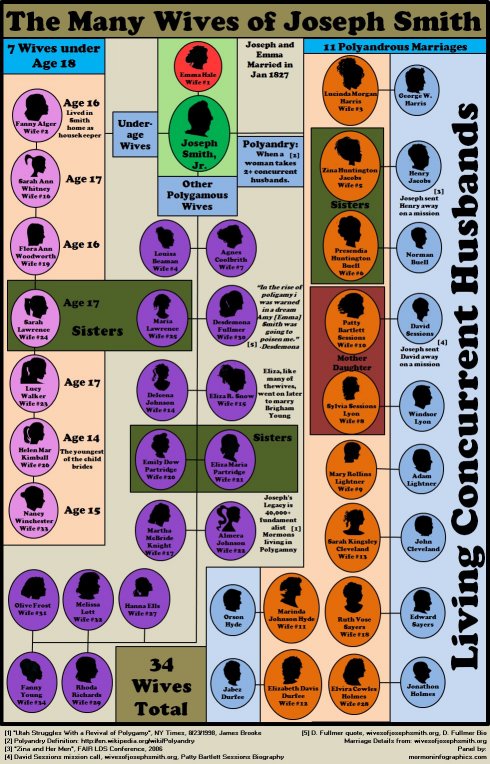
Modern Polyandrous Churches
The strange legacy of the first Mormon prophet has resulted in at least two off-shoots that have practiced polyandry. Though Mormonism abandoned polygamy before the turn of the 20th century, some 40,000 fundamentalist Mormons, who have broken away from the institutional LDS church, continue the practice. They have not, however, continued Smith's polyandry, and Brigham Young wisely allowed the founding prophet's abberant doctrines to be forgotten and to pass into oblivion. Not so, however, with some modern offshoots who dug deep into early Mormonism's beliefs and tried to recreate the Nauvoo marriage practices.
John W. Bryant, having left the Mormon Church and Mormon fundamentalist Rulon C. Allred's polygamous church, began claiming visions and revelations of his own from the resurrected John the apostle. Like Smith and all occultic organisations, he divided his Church - first known as the Evangelical Church of Christ (which mutated into the Patriarchal Church of Christ and then the Church of the New Covenant in Christ) - into a secret inner society called the 'Church of Enoch' and an outer public one called the 'Church of the Latter-day Saints'. To this he later added two more organizations as he began teaching Smith's controversial doctrines to increasingly smaller circles of initiates. His sexual communism, when it finally leaked out to the public, caused much local opposition and this, coupled with internal tensions as the 'uninitiated' discovered the secret polygamous practices of the 'initiated', finally caused his church to blow apart and scatter. Interestingly, he is now a self-confessed gnostic.
But this long story does not end here for within Byrant's organization was a young man called Gilbert Clark (who later renamed himself 'Davied Israel') took the teachings he had learned in the Evangelical Church of Christ and started his own group, calling it 'Sons Ahman Israel' (later renaming it Sons Auman Israel, possibly because he discovered that 'Ahman', the name by which Smith addressed his pagan god, was infact a demonic angel posing as an Egyptian deity). Clark introduced polyandry and mixed marriage into his group which has evolved to the natural end of Joseph Smith's Mormon doctrines, namely, occultism. Denying the Bible's inspiration, and only using three or four books within it within an occult context, Clark has created out of Mormonism's central ingredients and secret teachings of Joseph Smith another New Age cult and, like his predecessor John Bryant, has alligned himself with the gnostic movement, calling himself an 'Essene Christian'.
Conclusion
This historical study of polyandy has been made to show the origin of its spirit and to make a very clear distinction between polygyny and polyandry. The one is from Elohim (God), and the other is from the devil. Moreover, polygyny approached in the wrong way, without a proper biblical foundation, leads assuredly to cultism, inviting in destructive forces of a clearly demonic nature.
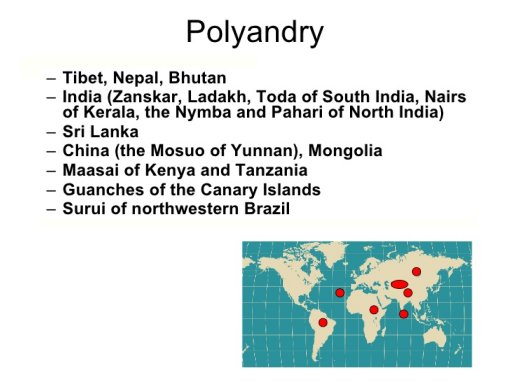 Places where polyandry has been practiced historically
Places where polyandry has been practiced historically
Polygyny is not, in any case, easy and should never be entered into by compulsion or without divine sanction or the mutual approbation of husband and wife. Any practice that deviates from the biblical pattern will only cause heartache and misery. We must learn the lessons of history.
Author: SBSK















































